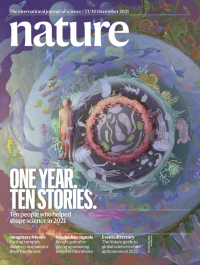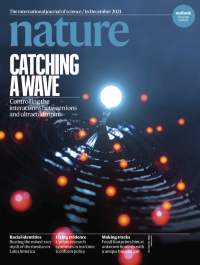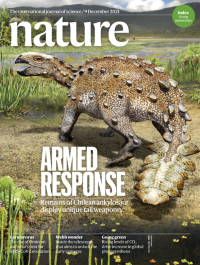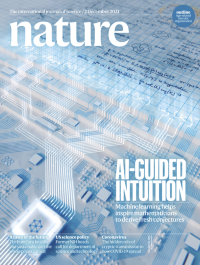Volume 600
-
No. 7890 23 December 2021
One year. Ten stories.As 2021 draws to a close, we look back at the past 12 months through the lens of Nature’s 10 — ten people who helped to shape science during the year. The cover explores the interconnected relationships of lifeforms on planet Earth — on oceans, land and air, and from microscopic organisms to the largest mammals. The vulnerability of our planet was a strong theme this year with global negotiations aimed at protecting biodiversity and averting the worst impacts of climate change.
Career Guide
-
No. 7889 16 December 2021
Catching a waveControlling physical systems at the level of individual molecules, atoms or ions underpins technologies such as quantum information processing and quantum metrology. Investigating collisions in a hybrid system of trapped atoms and ions has proved difficult to study at ultracold temperatures and as a result quantum phenomena have remained unobserved. In this week’s issue, Pascal Weckesser, Fabian Thielemann and their colleagues demonstrate quantum-mechanical interactions between an ultracold gas of lithium atoms and barium ions. The researchers use magnetic fields to tune and control the atom–ion interactions, observing ’wave-like’ interactions between them. This might help pave the way to quantum control of such hybrid systems, which could find use in quantum simulation and precision measurements. The cover offers an artistic impression of an individual ion interacting with several atoms with a wave-like character.
Nature Outlook
-
No. 7888 9 December 2021
Armed responseArmoured dinosaurs are widely recognized for their tail weapons, which include spikes in stegosaurs and tail clubs in ankylosaurs. In this week’s issue, Alexander Vargas and his colleagues present a new species of ankylosaur with an unusual tail weapon that resembles an Aztec war club. Found in southern Chile, the nearly complete skeleton of Stegouros elengassen dates to around 75 million years ago. The large tail weapon consists of seven pairs of flattened, bony deposits fused together in a frond-like structure. The researchers were able to determine that Stegouros is specifically related to the other Gondwanan ankylosaurs Kunbarrasaurus from Australia and Antarctopelta from Antarctica. They suggest that different branches of the ankylosaur family tree may have existed in Laurasia and Gondwana following the final separation of these supercontinents in the late Jurassic period.
Nature Index
-
No. 7887 2 December 2021
AI-guided intuitionPure mathematics involves the discovery of patterns between mathematical objects and using these connections to formulate conjectures. Mathematicians have deployed computers since the 1960s to help them uncover such patterns, but in this week’s issue, Alexander Davies and his colleagues demonstrate the use of machine learning for the process. First the algorithms search for patterns and relations between mathematical objects and try to make sense of them, then mathematicians use the observations to guide their intuition towards potential conjectures. The researchers applied their approach to two areas of mathematics, leading to the discovery of a new theorem in topology and a new conjecture in representation theory.
Nature Outline




